How to Preserve and Restore Healthy Soil
5 Steps to Building Healthy Soil During Construction
1. Retain and protect native topsoil & vegetation where practical
2. Restore construction-disturbed soils, to restore healthy soil functions, by:
stockpiling & reusing good quality site soil, or
tilling 2-3" of compost into poor site soils,
or bringing in 8" of compost-amended topsoil.
3. Loosen compacted subsoil, if needed, by ripping to 12" depth
4. Mulch landscape beds after planting
5. Protect restored soils from erosion or re-compaction by heavy equipment
Learn How from the “Tools” on this page, and these links:
Washington State’s Stormwater Manuals now require these soil best practices on every construction site, whether new or re-construction. In the Western Washington manual see Volume V, Chapter 5, BMP T5.13: Post-Construction Soil Quality and Depth (PDF). That BMP also provides “Flow credits” for runoff reduction when using these soil best practices.
Building Soil: Guidelines and Resources for Implementing BMP T5.13 (PDF) is Washington State’s designated guidance for implementing those required best practices on all construction sites. It includes: Soil preservation options and Amendment Calculations Spreadsheet (Excel file); How to develop a simple Soil Management Plan; a practical Field Inspection Guide and Field Verification Form; a list of soil testing labs; and the Department of Ecology’s Compost Facilities Suppliers List. Get started with the short Summary of the Building Soil Guide (PDF).
Washington’s Low Impact Development Manuals, especially the Western Washington LID Technical Guidance Manual for Puget Sound, show how these soil best practices fit into site development and other practices to slow and filter runoff. These LID manuals explain how to do all the practices that the State Stormwater Manual requires.
Seattle’s Green Stormwater Infrastructure site shows many examples. The Sustainable Landscaping Professionals site shows how to fit these practices into overall landscape design, construction, and maintenance. These soil best practices are also required in the national Sustainable Sites Standards, which are the site and landscape equivalent of the popular LEED green building standards.
King County’s Post-Construction Soil Standards site also has a handy compost and soil calculator, online soil management plan, and a great introductory video.
Other cities around Western Washington have also updated their codes to require these soil best practices - check with your local jurisdiction.
See more Examples of Successful Projects on this site.
Erosion Control with Compost Berms, Blankets, and Socks
Compost also is proving to be very effective in erosion control during and after construction, covering slopes (compost blankets) or in place of silt fence (compost berms or compost-filled filter socks). Builders get a 2-for-1 value by using compost for temporary erosion control, and then tilling it in to meet the post-construction soil quality requirement. Get more details in the EPA-erosion-control-specs (PDF)
Improving the Soil in Existing Landscapes
Soil organic matter is replenished in nature by leaf fall and decaying plants. This feeds the soil ecosystem, maintaining and building soil functions over the years. Soils need feeding in our built landscapes too. Simple methods are summarized in Natural Landscaping: Design, Build, Maintain and include:
Amend beds with compost when re-landscaping.
Annual mulching of existing landscape beds with shredded leaves, woodchips, bark, or compost. This builds the soil, prevents weeds, keeps plant roots warmer in winter and cooler in summer, and can cut summer irrigation needs by 50%!
On lawns, mulch-mowing or “grasscycling” – leaving the clippings to feed the soil, reduce fertilizer needs, and build lawn health. To learn about professional mulching mowers, fertilization, lawn restoration and more, see the “Lawns” section on the City of Seattle's Landscape Professionals website
Top-dress with compost to improve poor lawns, ¼ to ½ inch of compost raked in after aeration in spring or fall. See lawn manual above, and also Using Composts to Improve Turfgrass Performance (on Penn State University website)
Avoid overuse of soluble fertilizers and pesticides, which can damage beneficial soil life.
Information for Homeowners
Build it and they will come – the simple practices for existing landscapes described above are just as useful at home, for building organic matter to restore beneficial soil organisms. Benefits include healthier plants and lawns, fewer weeds, less need for chemicals, and lower summer water bills. Some good brochures for homeowners on all this include:
Natural Yard Care guides available in English and Spanish, along with Growing Healthy Soil, Composting, Natural Pest Control, Food Gardening, and other Natural Lawn and Garden Care guides (on City of Seattle website).

